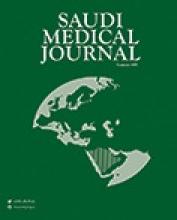Abstract
OBJECTIVE: To establish the anatomical relationships of the arytenoid and cricoid cartilages and apply these findings to design an arytenoidectomy based on a sound anatomical basis.
METHODS: We prospectively conducted this study between 1996 and 2002 at the Main University Hospital of Alexandria, Egypt. In 50 patients, we endoscopically measured the length of the vocal process and the distance between the vocal process tip and upper border of the cricoid cartilage. We sagittally and axially sectioned 25 total laryngectomy specimens to verify the position of the arytenoids and their relation to the cricoid. The anatomical findings led to the design of a laser partial arytenoidectomy and cordotomy (L-PAC), which we used in 45 patients with bilateral cord paralysis in adduction.
RESULTS: The anatomical findings showed that the cricoarytenoid joint did not contribute to the airway in any of the measured specimens. Using L-PAC, we decannulated 100% of the patients and no patient needed postoperative tracheostomy at any time. Only 3 patients experienced minimal postoperative aspiration to liquids (6.7%). We achieved reasonable phonation as assessed by a speech analysis battery. However, 3 patients (6.7%) needed contralateral L-PAC.
CONCLUSION: The present extra-articular technique, L-PAC, showed its superiority to previous endoscopic or transcervical complete arytenoidectomy techniques in providing an effective balance between the protective, respiratory, and to a lesser extent the phonatory functions.
- Copyright: © Saudi Medical Journal
This is an open-access article distributed under the terms of the Creative Commons Attribution-Noncommercial-Share Alike 3.0 Unported, which permits unrestricted use, distribution, and reproduction in any medium, provided the original work is properly cited.






